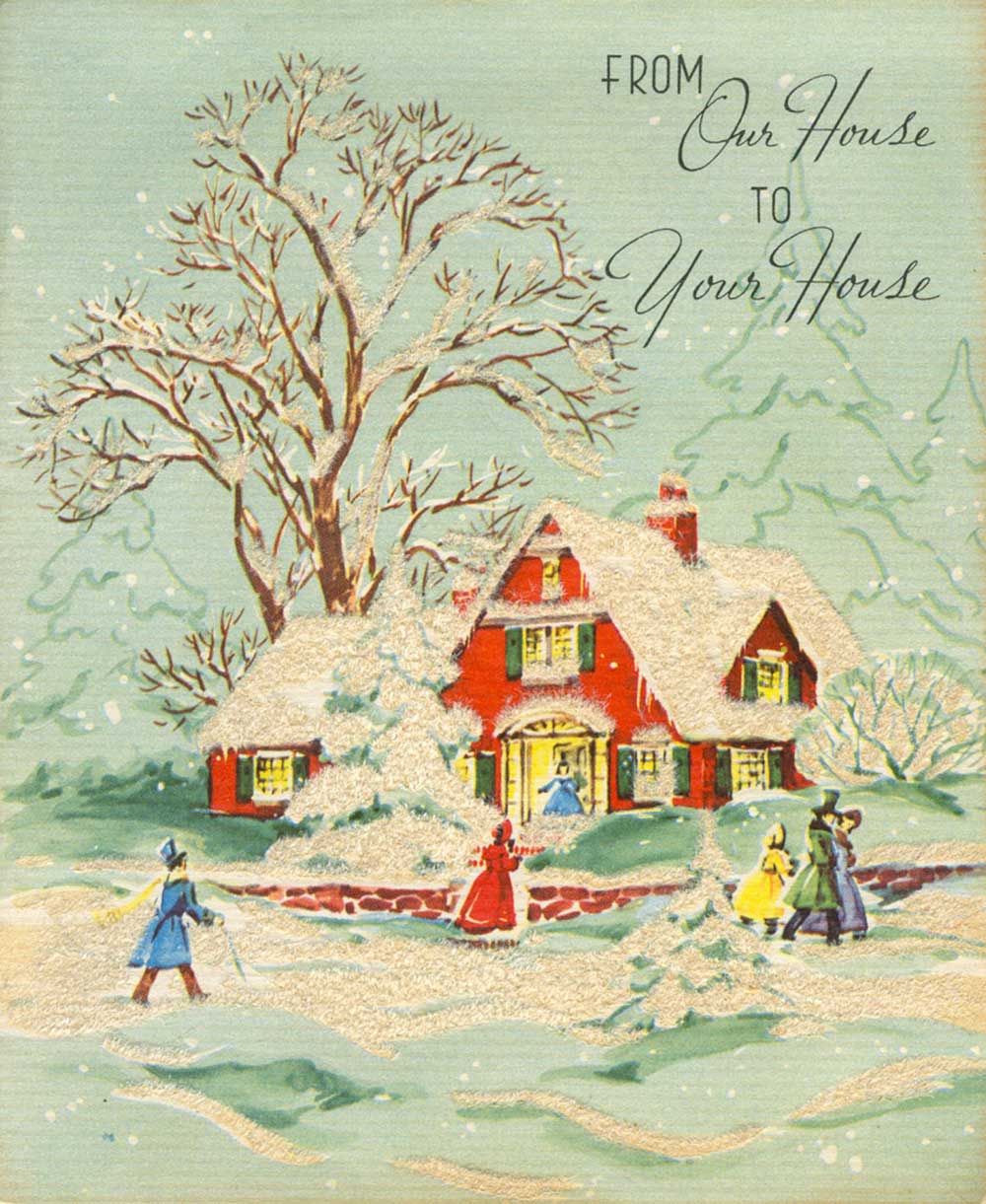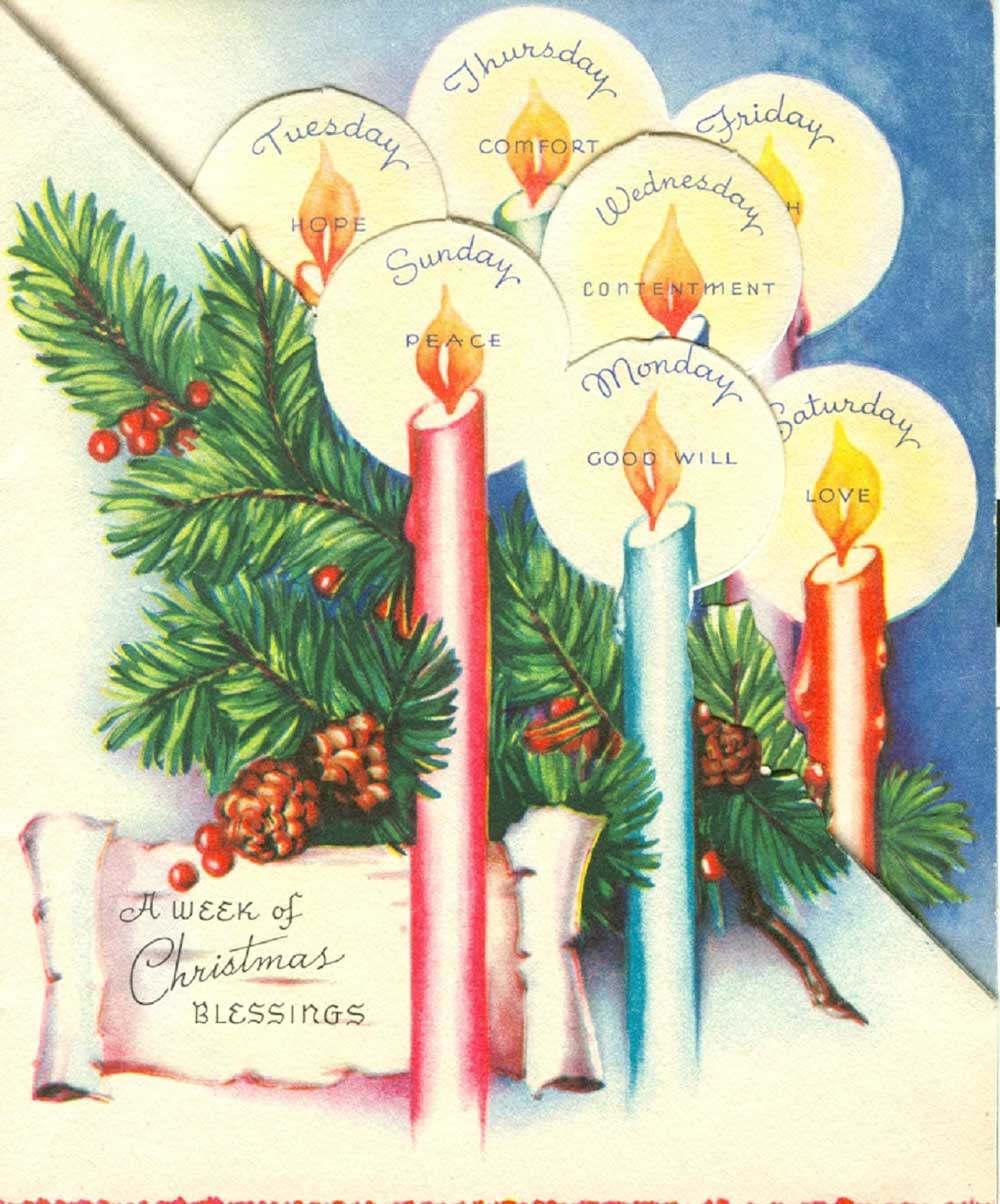December 2023
SMACK DAB IN THE MIDDLE
This month: ‘Just an old Christmas card’
by Donald-Brian Johnson
Here’s when the Christmas season really gets underway: one wintry day, amongst the deluge of bills and ads, your daily mail coughs up something out of the ordinary. Maybe it’s an envelope dotted with stenciled snowflakes. Maybe there’s a grinning snowman on an address label. But you know, even before opening it, exactly what you’ve received. It’s your first Christmas card. Let the holidays begin!
Commercially-produced Christmas cards first came to us courtesy of Sir Henry Cole, director of London’s Victoria & Albert Museum.
Cole had a tradition of sending handwritten holiday greetings to family and friends, but by 1843 the list was lengthy. Inspiration struck: he commissioned John Calcott Horsley, a member of the Royal Academy, to create a card that could be lithographed and colored by hand. “Extras” in the initial printing of 1,000 were then made available for sale to the general public.
Horsley’s 3” x 5” card illustrated three scenes: A family enjoying a holiday toast filled the central panel; the side panels featured folks performing charitable acts. The cards were roundly condemned, however, because one figure shown sipping wine in the central panel was a child. They were quickly withdrawn from the market; today, only about a dozen remain.
Over the next several years, the custom of card exchange grew in popularity, although initially only the wealthy could afford them. Then, thanks to the use of less costly paper and the development of the steam printing press, production costs plummeted. And, thanks to England’s Postal Act of 1840, even mailing a Christmas card was extremely affordable: postage was just a penny to anywhere in the United Kingdom.
In the United States, those sending “season’s greetings” had to make do with imported cards until 1875. That’s when Louis Prang, the “Father of the American Christmas Card,” began to sell them domestically. Prang’s “chromos” utilized zinc plates, which proved much less expensive than previous methods of color printing. The Christmas card tradition caught on here just as quickly as it had overseas; by the 1880s, Prang produced nearly five million cards annually.
By the 1920s, the Christmas card thematic pattern had become well-established, offering up a unique blend of nostalgia, sentiment, and season-specific visuals. Holiday wishes became particularly poignant during World War II, as greetings were sent to those overseas, keeping morale high, both at home and abroad.

“From Our House To Your House”
A Christmas greeting that never grows old: “From Our House To Your House,” by A & W, early 1950s. The homes are festooned with flocked snow. Image courtesy of Donald-Brian Johnson and Hank Kuhlman

Week Of Christmas Blessings
Each candle on this early-1950s “Week Of Christmas Blessings” offers a different wish. Among them: “Hope,” Peace,” and “Good Will.” Image courtesy of Donald-Brian Johnson and Hank Kuhlman
While later cards incorporated photo art, those of the 1940s and ‘50s relied mainly on illustration. Novelty additions, such as glitter, flocking, window cut-outs, pop-ups, and pull-out tabs were often used. Card trim could include everything from lace ribbon bows to cotton snowdrifts to metallic foil accents.
Photo Cards
Today, many families wouldn’t consider a Christmas card complete without a family photo. The fad began in the late 1930s, with amateur black-and-whites adorning semi-glossy one-sheets.
Studio Cards
More upscale than a box of dime store holiday cards, the “studio card” of the 1950s and ‘60s provided understated elegance at overstated cost. Each season’s selection was displayed to prospective buyers in humungous “sample books.”
Hi Brows
Instantly recognizable by their tall and narrow shape, “Hi Brows” were introduced by American Greetings in 1957. The “Hi Brow” deconstructed the traditional Christmas greeting, reconfiguring it as hip and offbeat, with just a dash of snarky humor.
Over the decades, Christmas cards have been prized, not only for their individual, intrinsic charm, but also for the nostalgic memories they evoke. Memories, if not of a time we personally recall, at least of a time we’ve heard about, or read about, or dreamed about. Arranged individually, or as part of a larger holiday display, vintage Christmas cards remain an extremely affordable collectible; most average well under $15. They also provide an ongoing visual impetus for peace and good will, not just at Christmastime, but year-round.
The mail is here–and so’s that first card. Merry Christmas to all!
Donald-Brian Johnson is the co-author of numerous Schiffer books on design and collectibles, including “Postwar Pop,” a collection of his columns. Please address inquiries to: donaldbrian@msn.com

